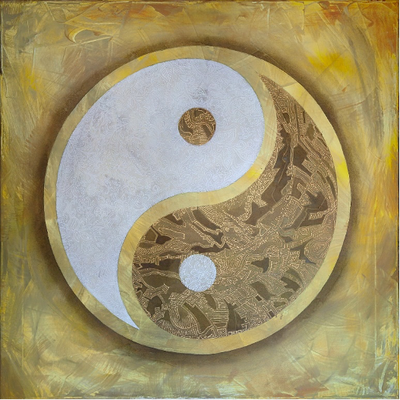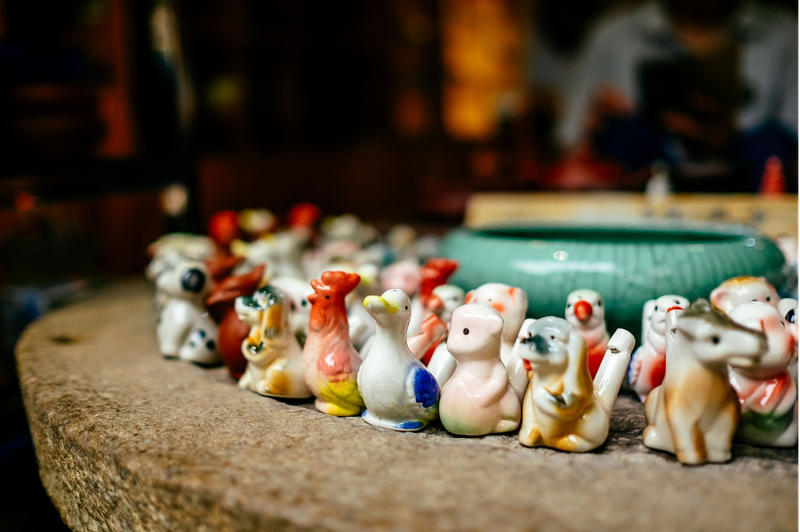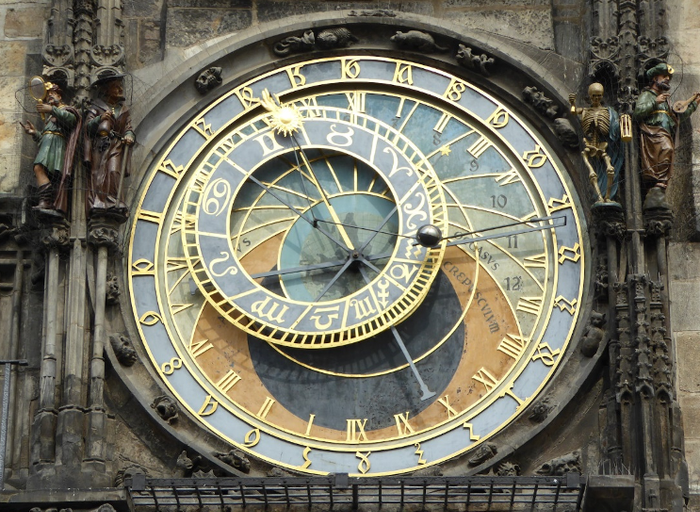Everything about the Chinese Zodiac - Chinese Astrology and Traditional Calendar
The Chinese zodiac is no doubt an important element of Chinese culture, and it's also an interesting topic!
On the surface, the Chinese zodiac is about the twelve animals based on one's birth year, which you are probably already familiar with. But there's a lot more to it to explore, and if you want to get a full picture, there's no way around the broader concept - and that includes the traditional Chinese calendar, Chinese astrology, and everything about ways to record time, days, months, seasons, and years.

Chinese Astrology
Chinese astrology is a complex topic that has a close relationship with traditional astronomy and the Chinese calendar system, and it is also related to Chinese philosophy, including the principles of 阴阳 (yin and yang).
There are many different concepts and ideas that belong to Chinese astrology, some of the main ones include 天干 (Earthly Branches), 地支 (Heavenly Stems), 五行 (five elements/phases), the lunisolar calendar (more often called the Lunar calendar), and the dating system for hours, days, months and years. This is a LOT of material, but we're going to break it down into easy-to-understand parts.
地支 (dì zhī), Earthly Branches
Let's start with 地支 - Earthly Branches.
There are twelve Earthly Branches (or Terrestrial Branches) in Chinese culture. They come in the following order:
| Order | 1 | 2 | 3 | 4 | 5 | 6 | 7 | 8 | 9 | 10 | 11 | 12 |
| Pinyin | zǐ | chǒu | yín | mǎo | chén | sì | wǔ | wèi | shēn | yǒu | xū | hài |
| Character | 子 | 丑 | 寅 | 卯 | 辰 | 巳 | 午 | 未 | 申 | 酉 | 戌 | 亥 |
It is an ordering system used in a variety of different contexts, such as in the ancient time/dating system, astrological traditions, zodiac, directions, and ordinals. It is widely used throughout the entirety of East Asia.
This system originates from astronomical observations of the orbit of Jupiter, and its near 12-year (11.86) orbital period was divided into 12 parts. Note that ancient Chinese astronomers called Jupiter 岁星 (suì xīng), which means the Year Star.
In retrospect, dividing it into 12 parts was pretty genius. Think about it - by using the 12-year Jupiter cycle, ancient Chinese people were able to use it for the 12 months of the year, seasons (there are 24 solar terms that correlate with seasons), the traditional Chinese 12 units of time (1 unit = 2 hours, together 24 hours), 24 cardinal directions (divisible by 4), and of course the famous Chinese zodiac. Basically, 12 is a really cool number and ancient Chinese people using Jovean astronomy was a stroke of brilliance.
In short, it's a great system for counting and directions, as well as for hours, months, seasons, and years.
天干 (tiān gān), Heavenly Stems
The Chinese calendar system also uses the 天干 (Heavenly Stems), in complement to 地支.
There are ten 天干 - Heavenly Stems (or Celestial Stems), which are used for the Chinese ordinal system:
| Order/Number | 1 | 2 | 3 | 4 | 5 | 6 | 7 | 8 | 9 | 10 |
| Pinyin | jiǎ | yǐ | bǐng | dīng | wù | jǐ | gēng | xīn | rén | guǐ |
| Character | 甲 | 乙 | 丙 | 丁 | 戊 | 己 | 庚 | 辛 | 壬 | 癸 |
The ten 天干 were originally used as names for the ten days of the week back in about 1250 BC.
天干 is used in combination with 地支 to give a total of 60 fundamental units - a sexagenary (60 unit) cycle, which provides a way to count days and years, including a 60-day cycle as well as a 60-year calendar cycle (we have included a table for the sexagenary cycle below).
In addition to the dating system, the 天干 is also and still used for Chinese numerals, mathematics, and even Organic Chemistry nomenclature in Chinese (think of it like the Latin or Greek roots in English).
天干地支 or 干支, Stems-and-Branches
Below is the Stems-and-Branches table (干支表), which shows the 60-unit cycle for the dating system. This can be used for hours, dates, months, and years.
| 01 甲子 | 11 甲戌 | 21 甲申 | 31 甲午 | 41 甲辰 | 51 甲寅 |
| 02 乙丑 | 12 乙亥 | 22 乙酉 | 32 乙未 | 42 乙巳 | 52 乙卯 |
| 03 丙寅 | 13 丙子 | 23 丙戌 | 33 丙申 | 43 丙午 | 53 丙辰 |
| 04 丁卯 | 14 丁丑 | 24 丁亥 | 34 丁酉 | 44 丁未 | 54 丁巳 |
| 05 戊辰 | 15 戊寅 | 25 戊子 | 35 戊戌 | 45 戊申 | 55 戊午 |
| 06 己巳 | 16 己卯 | 26 己丑 | 36 己亥 | 46 己酉 | 56 己未 |
| 07 庚午 | 17 庚辰 | 27 庚寅 | 37 庚子 | 47 庚戌 | 57 庚申 |
| 08 辛未 | 18 辛巳 | 28 辛卯 | 38 辛丑 | 48 辛亥 | 58 辛酉 |
| 09 壬申 | 19 壬午 | 29 壬辰 | 39 壬寅 | 49 壬子 | 59 壬戌 |
| 10 癸酉 | 20 癸未 | 30 癸巳 | 40 癸卯 | 50 癸丑 | 60 癸亥 |
Not only 干支 (Stems and Branches) can be used in combination, but individual 天干 and 地支 also have a relationship in respect for each other. Here, another table is provided below, which shows the correlation between 干支 with seasons and directions.
| 地支 | 子 | 丑 | 寅 | 卯 | 辰 | 巳 | 午 | 未 | 申 | 酉 | 戌 | 亥 |
| 天干 | 壬 | 己 | 甲 | 乙 | 戊 | 丁 | 丙 | 己 | 庚 | 辛 | 戊 | 癸 |
| Season | Winter | Winter | Spring | Spring | Spring | Summer | Summer | Summer | Fall | Fall | Fall | Winter |
| Direction | N | NE | NE | E | SE | SE | S | SW | SW | W | NW | NW |
| Degree | 0° | 30° | 60° | 90° | 120° | 150° | 180° | 210° | 240° | 270° | 300° | 330° |
Although 干支 are often used together in the traditional Chinese calendar system, this can get VERY complex, which is way beyond what we're going to talk about today.
A lot of the time, using only 地支 is more than enough for recording time and date, and they have a close relationship with the Chinese zodiac - which is discussed below.
五行 (wǔ xíng), the Five Elements/Phases
Now let's look at 五行.
What we have here are five elements - you may have heard of them, and they are related to the first five planets (excluding the Earth) in the solar system. See the list below:
| 五行 (Five Elements) | 行星 (Planet) | ||
| Chinese | English | Chinese | English |
| 金 (jīn) | Metal | 金星 | Venus |
| 木 (mù) | Wood | 木星 | Jupiter |
| 水 (shuǐ) | Water | 水星 | Mercury |
| 火 (huǒ) | Fire | 火星 | Mars |
| 土 (tǔ) | Earth/Soil | 土星 | Saturn |
Note that the contents of the table above are given in the order of 五行 and are not the same as the real order of the planets. Also pay attention to that土, which means earth or dirt, it is related to Saturn rather than Earth. In Chinese, Earth is 地球 (dì qiú).
五行 is a topic that relates to Chinese philosophy, alchemy, 风水 (fēng shuǐ, Feng Shui), traditional Chinese medicine, martial arts, and more.
Just as a simple introduction, the five phases of 五行 describe something like the cycles below - containing the cycles of generation/creation as well as destruction.

In addition to cycles, each element of 五行 also represents different directions, hours, and seasons, as shown by the table below. And they are also associated with different zodiac animals - we'll come back to this.
| Element | Planet | Hour | Season | Direction |
| 木 | Jupiter | 3-9 | Spring | East |
| 火 | Mars | 9-15 | Summer | South |
| 土 | Saturn | Change | Change (End of Summer) | Center |
| 金 | Venus | 15-21 | Fall | West |
| 水 | Mercury | 21-3 | Winter | North |
阴阳 (yīn yáng), Yin and Yang

阴阳 (Yin and Yang) is also a complex concept in Chinese culture. It is a Chinese philosophical concept describing forces that are interconnected yet opposite to each other. It can be viewed as balance in a chaotic universe.
阴 (Yin) is often associated with the Moon, darkness, the north, winter, femininity, and more. While 阳 (Yang) is often associated with the Sun, brightness, south, summer, masculinity, and so on. As such, the concept of 阴阳 is used can be used everywhere.
As that famous image of 阴阳 shown above, the dark side is 阴, and the white side is 阳. When it's used for the time of the day, you can view the daytime as 阳, and nighttime as 阴.
In addition, the Earthly Branches, Heavenly Stems, and zodiac animals also have their associations with 阴阳 - we will also come back to this!
节气 (jié qì) Solar Terms
In the traditional Chinese lunisolar calendar (usually just called the Lunar calendar), there are 24 periods based on the Sun's position, matching different astronomical events or natural phenomena, and they are called solar terms. Each solar term is spaced 15 degrees from its neighbors along the ecliptic, ensuring that the lunisolar calendar stays synchronized with seasons, and provides crucial guidance for farming.
This is why that traditional calendar, although mainly matches the Moon's phases, is called a lunisolar calendar and 农历 (nóng lì, agricultural/farming calendar) in Chinese.
The list of the 24 solar terms is given below.
As seen from the table, each season has 6 solar terms, and the date of each solar term is based on the Gregorian calendar (the normal Western calendar), not the traditional lunisolar calendar. We will later show the relationship between each solar term with the traditional calendar.
Note that due to the distance between the Earth and the Sun varying slightly, the time taken for the Sun to travel between the solar terms also varies. Therefore, the dates for each solar term are given a range.
| Season | Solar Term | Longitude | Dates | Season | Solar Term | Longitude | Dates |
| 春 Spring | 立春 (lì chūn) | 315° | Feb 3-5 | 秋 Fall | 立秋 (lì qiū) | 135° | Aug 7-9 |
| 雨水 (yǔ shuǐ) | 330° | Feb 18-20 | 处暑 (chù shǔ) | 150° | Aug 22-24 | ||
| 惊蛰 (jīng zhé) | 345° | Mar 5-7 | 白露 (bái lù) | 165° | Sep 7-9 | ||
| 春分 (chūn fēn) | 0° | Mar 20-22 | 秋分 (qiū fēn) | 180° | Sep 22-24 | ||
| 清明 (qīng míng) | 15° | Apr 4-6 | 寒露 (hán lù) | 195° | Oct 8-9 | ||
| 谷雨 (gǔ yǔ) | 30° | Apr 19-21 | 霜降 (shuāng jiàng) | 210° | Oct 23-24 | ||
| 夏 Summer | 立夏 (lì xià) | 45° | May 5-7 | 冬 Winter | 立冬 (lì dōng) | 225° | Nov 7-8 |
| 小满 (xiǎo mǎn) | 60° | May 20-22 | 小雪 (xiǎo xuě) | 240° | Nov 22-23 | ||
| 芒种 (máng zhòng) | 75° | Jun 5-7 | 大雪 (dà xuě) | 255° | Dec 6-8 | ||
| 夏至 (xià zhì) | 90° | Jun 21-22 | 冬至 (dōng zhì) | 270° | Dec 21-23 | ||
| 小暑 (xiǎo shǔ) | 105° | Jul 6-8 | 小寒 (xiǎo hán) | 285° | Jan 5-7 | ||
| 大暑 (dà shǔ) | 120° | Jul 22-24 | 大寒 (dà hán) | 300° | Jan 20-21 |
生肖 (shēng xiào) Chinese Zodiac

At last, with all the information above, it's time for us to dive into the concept of the Chinese zodiac, which is 生肖 in Chinese!
Are you ready?!
Don't be worried, this concept is actually quite simple.
We know that there are twelve zodiac signs or animals. Recall the things we've mentioned above, what also has twelve parts? That's right! 地支, the Earthly Branches! And they do have a very close relationship.
Unlike the Western zodiac, which is based on constellations from Western astrology and corresponds to months, the Chinese zodiac is associated with 地支, Earthly Branches, and they represent years, instead of months (though they also have an association with months through 地支).
Each new zodiac year starts on the first day of the Chinese Lunar New Year, and together it's a twelve-year cycle.
To put it simply, each of the Chinese zodiacs represents one of the 地支. In other words, you can view the zodiac animal signs as mascots of 地支. This is similar to the Western constellations that all have their astrology signs.
So sometimes when people talk about 生肖, the Chinese zodiac, they are also talking about 地支, and vice versa.
As a result, the Chinese zodiac which is an important part of Chinese astrology as well, and because of its close association with 地支, is also connected to other astrology concepts. To be more specific, there are relationships with the zodiac and the systems we talked about above - years, months, solar terms, and even hours.
In addition, each of the zodiac animals also has certain characteristics by having its own fixed properties of 阴阳, Yin-Yang, as well as 五行, five elements/phases.
Now let's put all the pieces together!
What you can see below is a quite comprehensive table for almost everything we've talked about so far, and they all relate to 生肖, the Chinese zodiac!
| 生肖 Zodiac | 地支 Earthly Branch | Year[a] (Gregorian Dates) | Modern Hour[b] | Lunar Month | 五行 Element | 阴阳 Yin-Yang |
| 鼠 (shǔ), Rat | 子 (zǐ) | Jan 25, 2020 - Feb 11, 2021 | 12 - 2 am | 十一月 - 11th | 水, Water | 阳, Yang |
| 牛 (niú), Ox | 丑 (chǒu) | Feb 12, 2021 - Jan 31, 2022 | 2 - 4 am | 腊月 - 12th | 土, Earth | 阴, Yin |
| 虎 (hǔ), Tiger | 寅 (yín) | Feb 01, 2022 - Jan 21, 2023 | 4 - 6 am | 正月 - 1st | 木, Wood | 阳, Yang |
| 兔 (tù), Rabbit | 卯 (mǎo) | Jan 22, 2023 - Feb 09, 2024 | 4 - 8 am | 二月 - 2nd | 木, Wood | 阴, Yin |
| 龙 (lóng), Dragon | 辰 (chén) | Feb 10, 2024 - Jan 28, 2025 | 8 - 10 am | 三月 - 3rd | 土, Earth | 阳, Yang |
| 蛇 (shé), Snake | 巳 (sì) | Jan 29, 2025 - Feb 16, 2026 | 10 am - 12 pm | 四月 - 4th | 火, Fire | 阴, Yin |
| 马 (mǎ), Horse | 午 (wǔ) | Feb 17, 2026 - Feb 05, 2027 | 12 - 2 pm | 五月 - 5th | 火, Fire | 阳, Yang |
| 羊 (yáng), Goat | 未 (wèi) | Feb 06, 2027 - Jan 25, 2028 | 2 - 4 pm | 六月 - 6th | 土, Earth | 阴, Yin |
| 猴 (hóu), Monkey | 申 (shēn) | Jan 26, 2028 - Feb 12, 2029 | 4 - 6 pm | 七月 - 7th | 金, Metal | 阳, Yang |
| 鸡 (jī), Rooster | 酉 (yǒu) | Feb 13, 2029 - Feb 02, 2030 | 6 - 8 pm | 八月 - 8th | 金, Metal | 阴, Yin |
| 狗 (gǒu), Dog | 戌 (xū) | Feb 03, 2030 - Jan 22, 2031 | 8 - 10 pm | 九月 - 9th | 土, Earth | 阳, Yang |
| 猪 (zhū), Pig | 亥 (hài) | Jan 23, 2031 - Feb 10, 2032 | 10 pm - 12 am | 十月 - 10th | 水, Water | 阴, Yin |
[a]One 12-year cycle starting from 2020, note that the dates of each zodiac year are based on the Chinese traditional lunisolar calendar (starts on Chinese New Year). The bolded number is the year for that lunisolar Chinese year.
[b]Some source indicates that the modern hours are 1 hour earlier than what we've shown here. For example, 子时 (the time range for 子) is 11 pm - 1 am, and the rest moves one hour up.
Chinese Zodiac vs. Western Zodiac

Because of the correlation with months for the Chinese zodiac through 地支, we can also derive a relationship between the Chinese and Western zodiacs.
As demonstrated in the table below, we are able to compare Chinese and Western zodiacs. They don't match in a one-to-one manner, but rather there is a half-off pattern.
In fact, the Western zodiac has a closer relationship with the solar terms, since both are based on the Earth's orbit around the Sun. The main difference between Western zodiac and solar terms is that each solar term is a specific date when the ecliptic longitude is at a value of some number times 15° (see the table for solar terms above); while each Western zodiac lasts for about a month, and covers over a total of 30° range of the ecliptic longitude (e.g., Aries is 0-30°, Taurus is 30-60°, and so on).
| 生肖 Zodiac | 地支 Earthly Branch | Lunar Month | 节气 Solar Term | Approx. Date (Gregorian) | Approx. Western Zodiac |
| 鼠 (shǔ), Rat | 子 (zǐ) | 十一月 - 11th | 大雪 (dà xuě) | Dec 6-8 | Sagittarius ♐︎ |
| 冬至 (dōng zhì) | Dec 21-23 | Capricorn ♑︎ | |||
| 牛 (niú), Ox | 丑 (chǒu) | 腊月 - 12th | 小寒 (xiǎo hán) | Jan 5-7 | |
| 大寒 (dà hán) | Jan 20-21 | Aquarius ♒︎ | |||
| 虎 (hǔ), Tiger | 寅 (yín) | 正月 - 1st | 立春 (lì chūn) | Feb 3-5 | |
| 雨水 (yǔ shuǐ) | Feb 18-20 | Pisces ♓︎ | |||
| 兔 (tù), Rabbit | 卯 (mǎo) | 二月 - 2nd | 惊蛰 (jīng zhé) | Mar 5-7 | |
| 春分 (chūn fēn) | Mar 20-22 | Aries ♈︎ | |||
| 龙 (lóng), Dragon | 辰 (chén) | 三月 - 3rd | 清明 (qīng míng) | Apr 4-6 | |
| 谷雨 (gǔ yǔ) | Apr 19-21 | Taurus ♉︎ | |||
| 蛇 (shé), Snake | 巳 (sì) | 四月 - 4th | 立夏 (lì xià) | May 5-7 | |
| 小满 (xiǎo mǎn) | May 20-22 | Gemini ♊︎ | |||
| 马 (mǎ), Horse | 午 (wǔ) | 五月 - 5th | 芒种 (máng zhòng) | Jun 5-7 | |
| 夏至 (xià zhì) | Jun 21-22 | Cancer ♋︎ | |||
| 羊 (yáng), Goat | 未 (wèi) | 六月 - 6th | 小暑 (xiǎo shǔ) | Jul 6-8 | |
| 大暑 (dà shǔ) | Jul 22-24 | Leo ♌︎ | |||
| 猴 (hóu), Monkey | 申 (shēn) | 七月 - 7th | 立秋 (lì qiū) | Aug 7-9 | |
| 处暑 (chù shǔ) | Aug 22-24 | Virgo ♍︎ | |||
| 鸡 (jī), Rooster | 酉 (yǒu) | 八月 - 8th | 白露 (bái lù) | Sep 7-9 | |
| 秋分 (qiū fēn) | Sep 22-24 | Libra ♎︎ | |||
| 狗 (gǒu), Dog | 戌 (xū) | 九月 - 9th | 寒露 (hán lù) | Oct 8-9 | |
| 霜降 (shuāng jiàng) | Oct 23-24 | Scorpio ♏︎ | |||
| 猪 (zhū), Pig | 亥 (hài) | 十月 - 10th | 立冬 (lì dōng) | Nov 7-8 | |
| 小雪 (xiǎo xuě) | Nov 22-23 | Sagittarius ♐︎ |
In this article, we took a deep dive into everything about the Chinese zodiac and the related concepts of Chinese astrology.
We also made a simple lesson on the Chinese zodiac in our graded reader app. If you're interested in learning and practicing your Chinese language skills while reading about Chinese culture, this is a great place to go!
There is also an article on time and dates in Chinese. It mainly goes over the basic concepts and words to know if you want to talk about time and dates with others. Feel free to check it out!